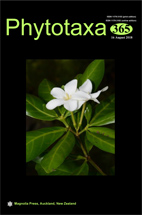Abstract
A new corticioid species, Dacryobolus angiospermarum, is described and illustrated from southern China based on morphological and molecular evidence. The new species is similar to D. karstenii but differs in growing on angiosperm wood, having wider skeletal hyphae, and lacking hymenial cystidia. In the phylogenetic tree inferred from ITS and nrLSU sequence of Dacryobolaceae, D. angiospermarum formed a distinct lineage sister to the D. karstenii group. Samples of D. karstenii from southern China, north Europe and northwestern United States formed different lineages. However, no morphological characters can be used to distinguish them at present.
References
Binder, M., Justo, A., Riley, R., Salamov, A., Lopez-Giraldez, F., Sjokvist, E., Copeland, A., Foster, B., Sun, H., Larsson, E., Larsson, K.H., Townsend, J., Grigoriev, I.V. & Hibbett, D.S. (2013) Phylogenetic and phylogenomic overview of the Polyporales. Mycologia 105: 1350–1373.
https://doi.org/10.3852/13-003
Brefeld, O. (1888) Basidiomyceten III. Autobasidiomyceten. Untersuchungen aus dem Gesammtgebiete der Mykologie 8: 1–184.
Chen, Y.Y. & Cui, B.K. (2015) Phylogenetic analysis and taxonomy of the Antrodia heteromorpha complex in China. Mycoscience 57: 1–10.
https://doi.org/10.1016/j.myc.2015.07.003
Dai, Y.C. (2011) A revised checklist of corticioid and hydnoid fungi in China for 2010. Mycoscience 52: 69–79.
https://doi.org/10.1007/S10267-010-0068-1
Eriksson, J. & Ryvarden, L. (1975) The Corticiaceae of North Europe 4. Coronicium–Hyphoderma. 288–546. Fungiflora. Oslo, Norway.
Felsenstein, J. (1985) Confidence intervals on phylogenetics: an approach using bootstrap. Evolution 39: 783–791.
https://doi.org/10.2307/2408678.
Fries, E.M. (1849) Summa vegetabilium Scandinaviae 2: 259–572.
Fries, E.M. (1874) Hymenomycetes europaei. 755 pp.
Ginns, J. & Lefebvre, M.N.L. (1993) Lignicolous corticioid fungi of North America. Mycologia Memoirs 19: 1–247.
Justo, A., Miettinen, O., Floudas, D., Ortiz-Santana, B., Sjökvist, E., Lindner, D.L., Nakasone, K.K., Niemelä, T., Larsson, K.H., Ryvarden, L. & Hibbett, D.S. (2017) A revised family-level classification of the Polyporales (Basidiomycota). Fungal Biology 121: 798–824. https://doi.org/10.1016/j.funbio.2017.05.010
Katoh, K. & Toh, H. (2008) Recent developments in the MAFFT multiple sequence alignment program. Brief Bioinform 9: 286–298. https://doi.org/10.1093/bib/bbn013
Kornerup, A. & Wanscher, J.H. (1978) Methuen handbook of colour. 3rd Ed. Eyre Methuen, London, England, 252 pp.
Manjón, J.L., Hjortstam, K. & Moreno, G. (1984) Dacryobolus phalloides sp. nov. (Corticiaceae). Anales del Jardín Botánico de Madrid 40: 297–301.
Murrill, W.A. (1905) The Polyporaceae of North America: XII. A synopsis of the white and bright-colored pileate species. Bulletin of the Torrey Botanical Club 32: 469–493.
https://doi.org/10.2307/2478463
Nuss, I. (1980) Untersuchungen zur systematischen Stellung der Gattung Polyporus. Hoppea Denkschrift der Regensburgischen Naturforschenden Gesellschaft 39: 127–198.
Ortiz-Santana, B., Lindner, D.L., Miettinen, O., Justo, A. & Hibbett, D.S. (2013) A phylogenetic overview of the antrodia clade (Basidiomycota, Polyporales). Mycologia 105: 1391–1411.
https://doi.org/10.3852/13-051
Parmasto, E. (1968) Conspectus Systematis Corticiacearum. 261 pp.
Rattan, S.S. (1977) The resupinate Aphyllophorales of the North Western Himalayas. Bibliotheca Mycologica 60: 1–427.
Singer, R. (1944) Notes on taxonomy and nomenclature of the polypores. Mycologia 36: 65–69.
https://doi.org/10.2307/3754880
Stamatakis, A. (2006) RAxML-VI-HPC: Maximum likelihood-based phylogenetic analyses with thousands of taxa and mixed models. Bioinformatics 22: 2688–2690.
https://doi.org/10.1093/bioinformatics/btl446
Swofford, D.L. (2002) PAUP*: Phylogenetic analysis using parsimony (*and other methods). Version 4.0b10. Sinauer Associates, Sunderland, Massachusetts.
Vlasák, J., Vlasák, Jr. J. & Cui, B.K. (2013) Antrodia kmetii, a new European polypore similar to Antrodia variiformis. Cryptogamie Mycologie 34: 203–209.
https://doi.org/10.7872/crym.v34.iss2.2013.203
White, T.J., Bruns, T.D., Lee, S. & Taylor, J. (1990) Amplification and direct sequencing of fungal ribosomal RNA genes for phylogenetics. In: Innis, M.A., Gelfand, D.H., Sninsky, J.J. & White, T.J. (Eds.) PCR protocols, a guide to methods and applications. Academic, San Diego, pp 315–322.
https://doi.org/10.1016/B978-0-12-372180-8.50042-1
Wu, S.H. (2003) Lignicolous Homobasidiomycetes newly recorded from Taiwan. Mycotaxon 88: 373–376.
Yuan, H.S., Kan, Y.H. & Wan, X.Z. (2016) Two new brown-rot corticioid fungi in Dacryobolus (Basidiomycota) from southwestern China. Phytotaxa 265 (2): 101–111.
https://doi.org/10.11646/phytotaxa.265.2.1

